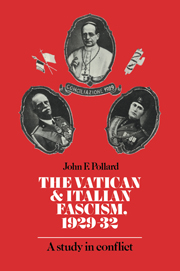Book contents
- Frontmatter
- Contents
- Acknowledgements
- Abbreviations
- 1 INTRODUCTION
- 2 THE ADVENT OF THE CONCILIAZIONE
- 3 REACTIONS TO THE CONCILIAZIONE AND THE RATIFICATION OF THE PACTS
- 4 THE DIPLOMATIC DIMENSION: ITALIAN FOREIGN POLICY AND THE VATICAN, 1929–31
- 5 THE CATHOLIC OFFENSIVE: CATHOLIC ACTION AND THE REGIME, 1929–31
- 6 THE CRISIS OF 1931
- 7 CONCLUSION AND EPILOGUE
- Appendix I The Law of Guarantees of 1871
- Appendix II The Lateran Pacts of 1929
- Appendix III The September Accords, 1931
- Appendix IV A note on archival and other sources
- Bibliography
- Index
- Frontmatter
- Contents
- Acknowledgements
- Abbreviations
- 1 INTRODUCTION
- 2 THE ADVENT OF THE CONCILIAZIONE
- 3 REACTIONS TO THE CONCILIAZIONE AND THE RATIFICATION OF THE PACTS
- 4 THE DIPLOMATIC DIMENSION: ITALIAN FOREIGN POLICY AND THE VATICAN, 1929–31
- 5 THE CATHOLIC OFFENSIVE: CATHOLIC ACTION AND THE REGIME, 1929–31
- 6 THE CRISIS OF 1931
- 7 CONCLUSION AND EPILOGUE
- Appendix I The Law of Guarantees of 1871
- Appendix II The Lateran Pacts of 1929
- Appendix III The September Accords, 1931
- Appendix IV A note on archival and other sources
- Bibliography
- Index
Summary
On 11 February 1929, Pietro Gasparri, Cardinal Secretary of State to Pope Pius XI, and Benito Mussolini, Duce of Fascism and Head of the Italian Government, signed the Treaties of the Lateran, bringing to an end the ‘Roman Question’, the sixty-year-old dispute between the Papacy and the Kingdom of Italy.
In common with other Church and State disputes in the nineteenth and twentieth centuries, the ‘Roman Question’ had its origins in an ideological conflict, a conflict between the secularising and modernising tendencies of Liberalism and the resistance to this development on the part of the Catholic Church. Like other European Liberals, the Italian Moderate Liberals led by D'Azeglio and Cavour enacted a series of laws, first in Piedmont and then in the rest of Italy, which wrested control of such matters as education, marriage and censorship from the Church, established freedom of religion for Protestants and Jews, dissolved many of the contemplative religious orders and confiscated a substantial portion of the property of the Church.
But the Church and State dispute in Italy had a dimension that sharply differentiated it from similar disputes elsewhere, for the process of Italian unification necessarily involved the destruction of the Pope's temporal power, that is his sovereignty over the Papal States of central Italy. In September 1870, the last remnant of that sovereignty was extinguished when Italian troops occupied the City of Rome and made it the capital of Italy. Despite all the attempts by Cavour and his successors to find a compromise solution, Pius IX refused to accept the loss of the temporal power.
- Type
- Chapter
- Information
- The Vatican and Italian Fascism, 1929–32A Study in Conflict, pp. 1 - 14Publisher: Cambridge University PressPrint publication year: 1985

